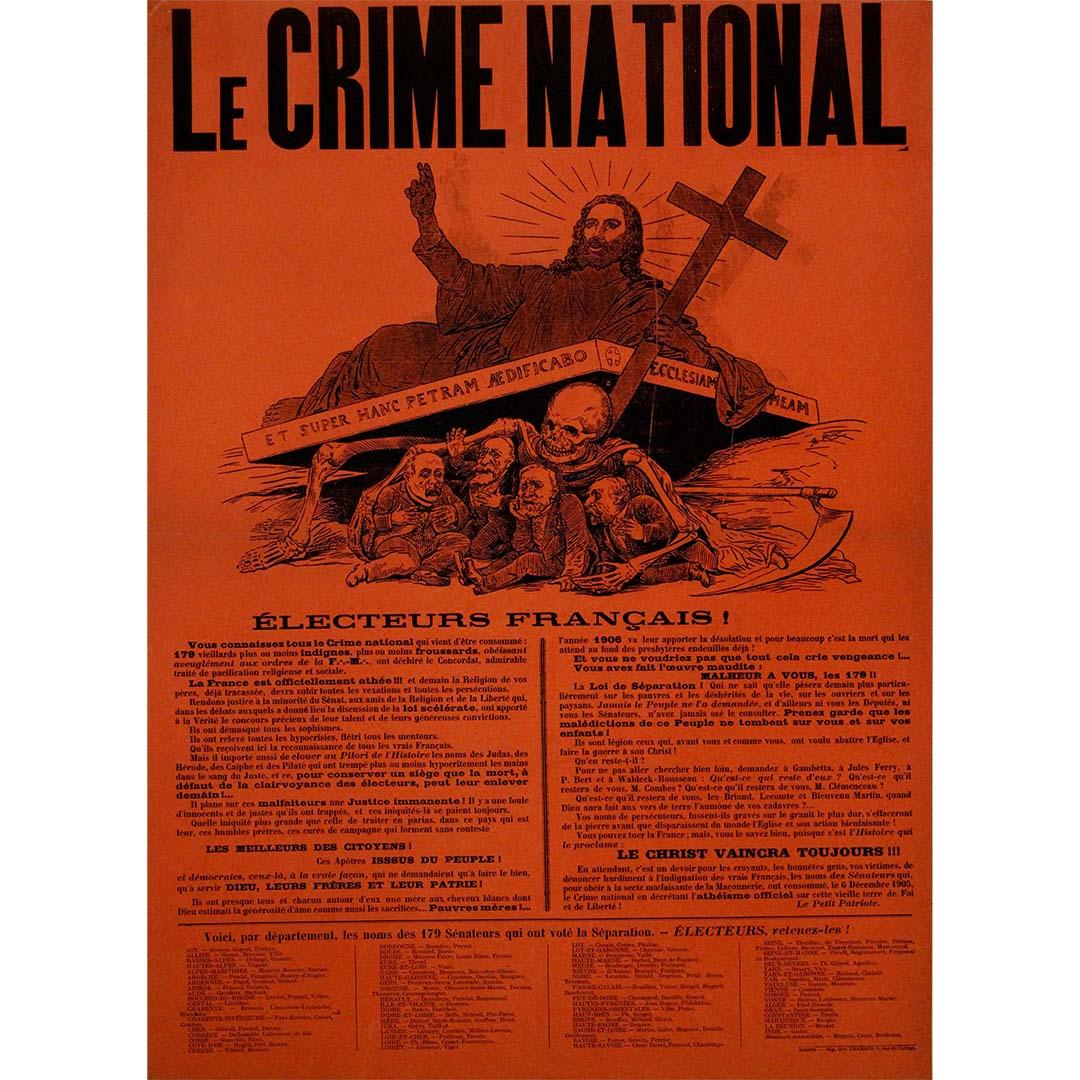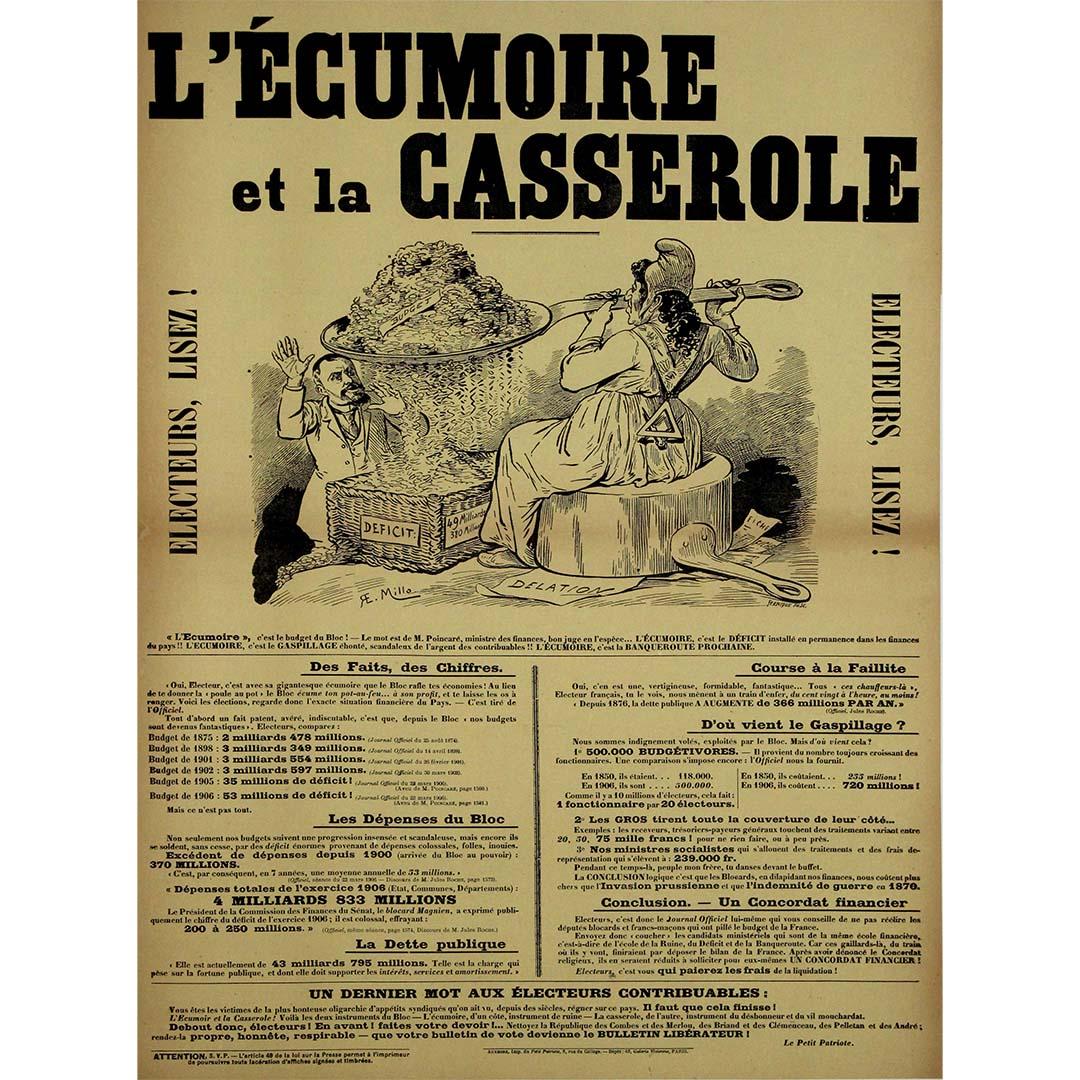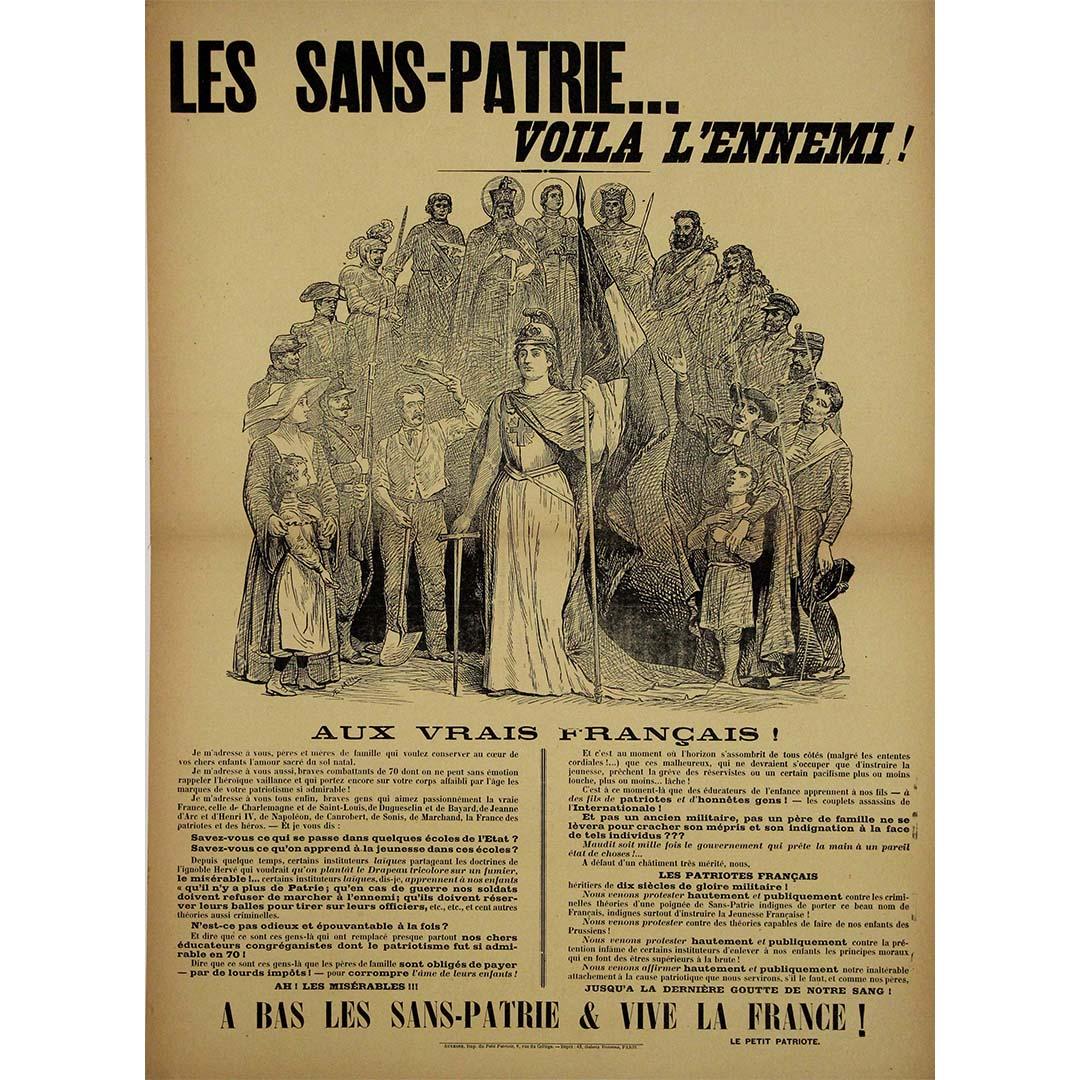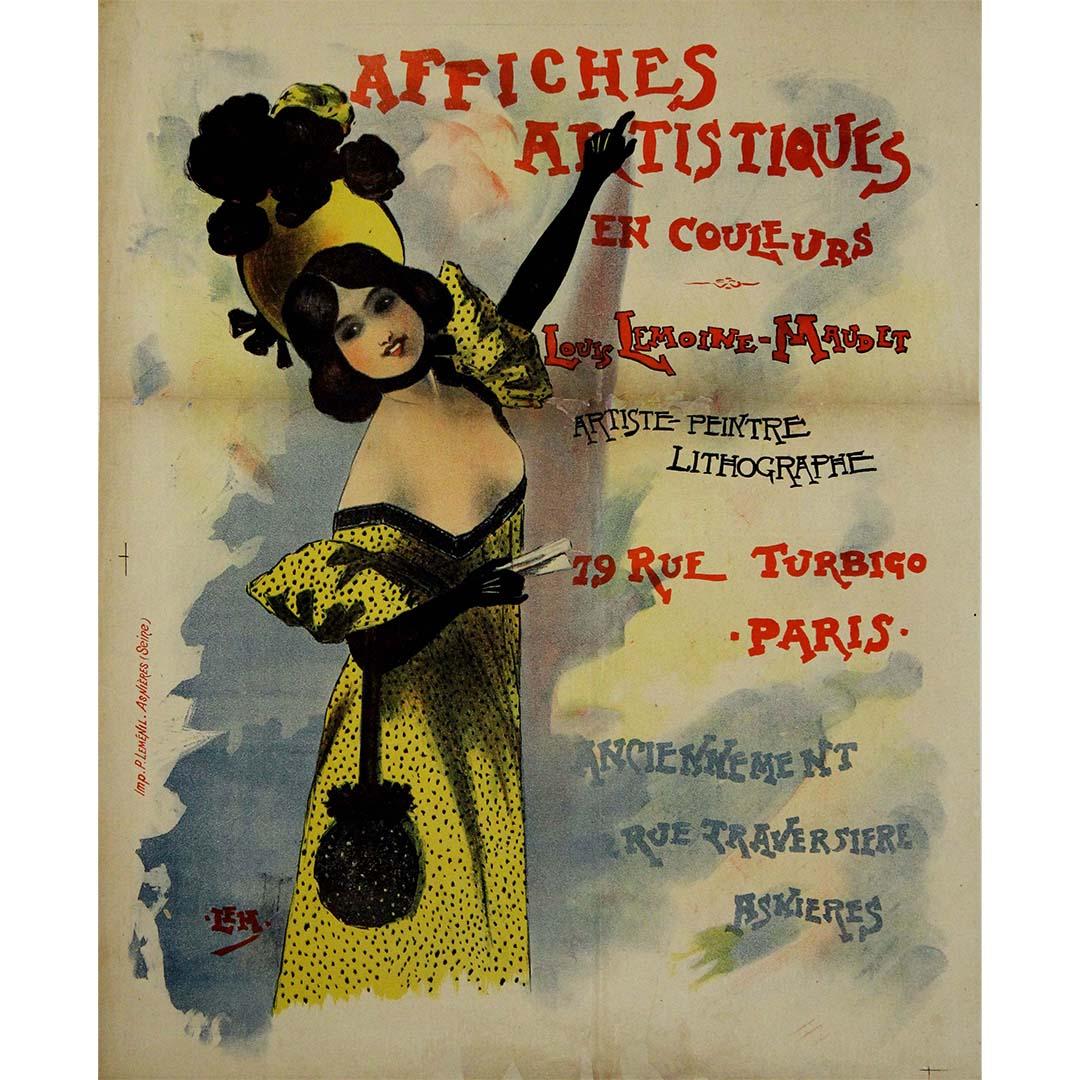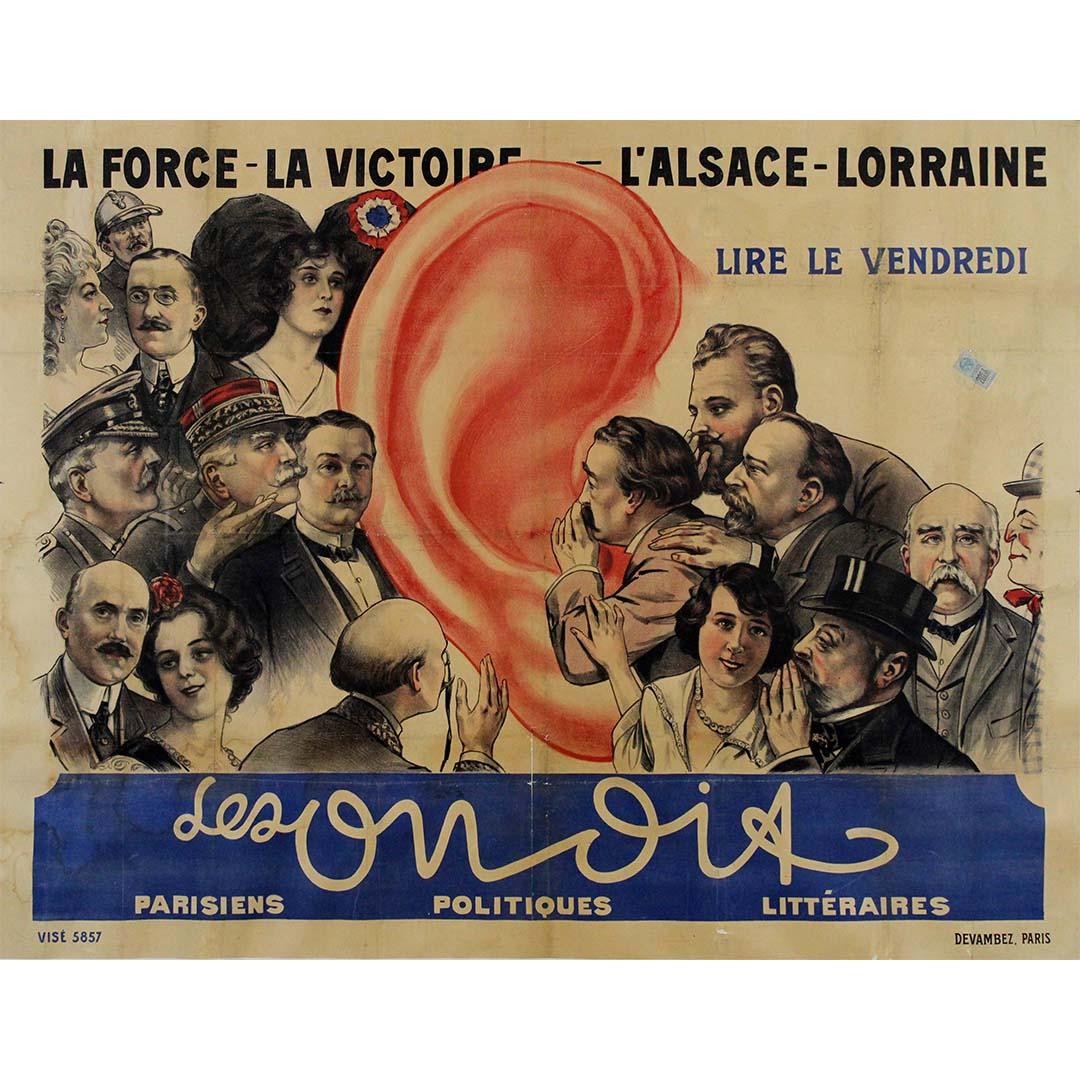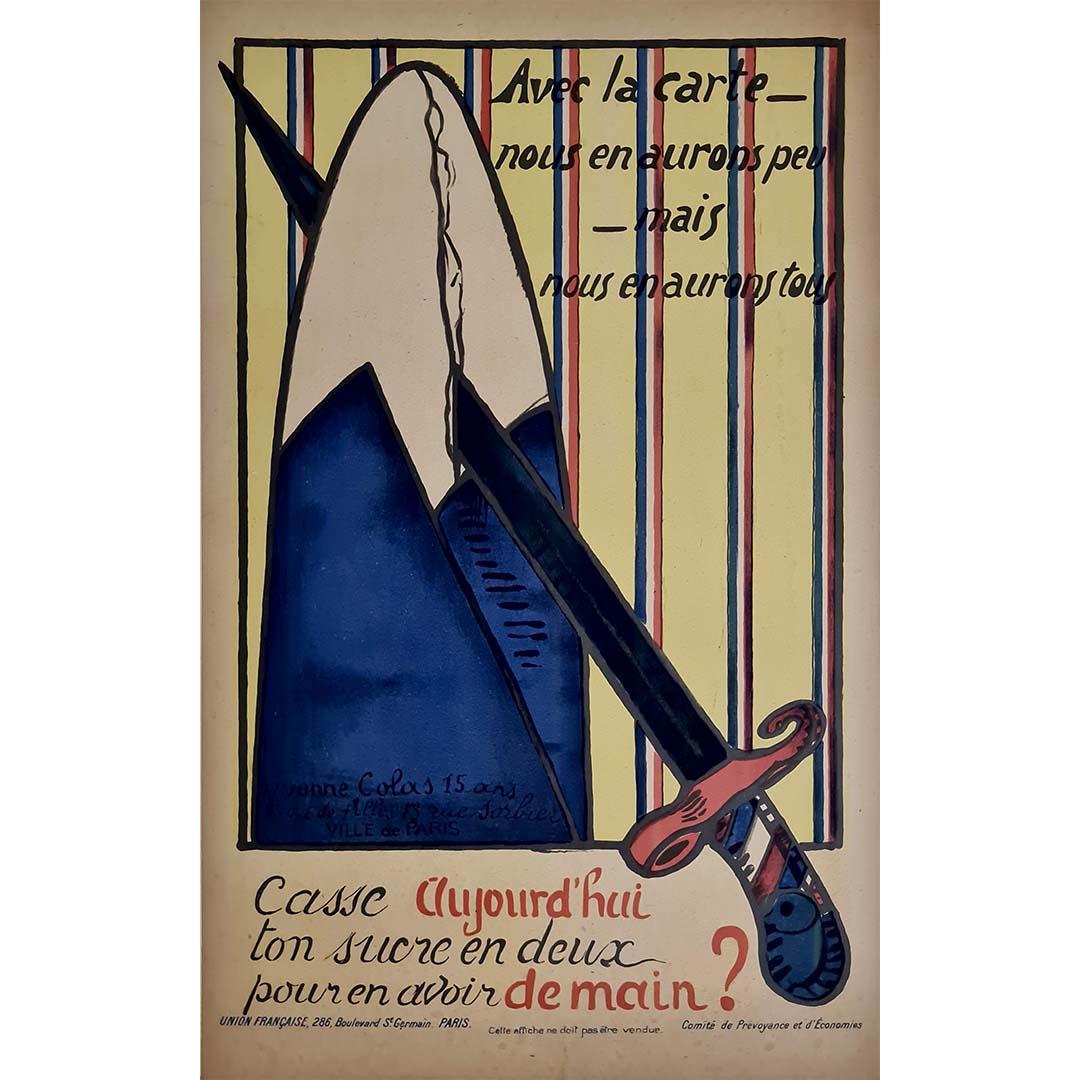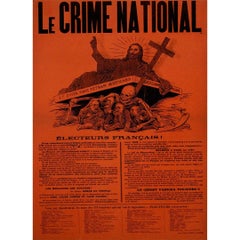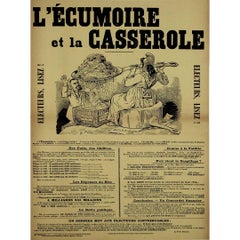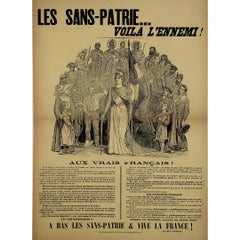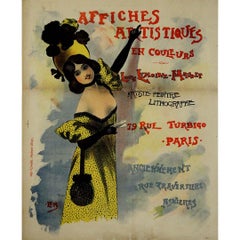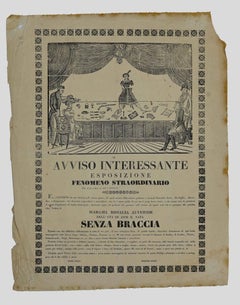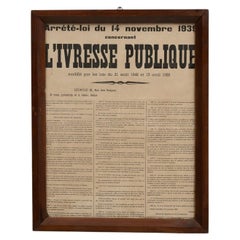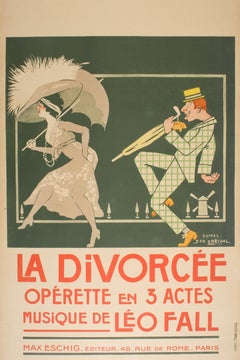Items Similar to Early 20th century original poster - Law on the Separation of Church and State
Want more images or videos?
Request additional images or videos from the seller
1 of 8
E. MilloEarly 20th century original poster - Law on the Separation of Church and StateCirca 1908
Circa 1908
$1,306.55
£973.95
€1,100
CA$1,821.15
A$1,979.28
CHF 1,045.97
MX$23,945.03
NOK 13,026.85
SEK 12,304.67
DKK 8,377
About the Item
The early 20th century was a period of intense ideological struggle in France, particularly between Catholics and secularists. The 1905 Law on the Separation of Church and State had firmly established laïcité (secularism) as the guiding principle of the Republic, but it also triggered fierce backlash from religious conservatives.
The poster "Laïcisateurs et Comédiens" (Secularists and Comedians), attributed to E. Millo, is a powerful example of anti-secular propaganda that denounces what its authors saw as the hypocrisy and oppression of the French government’s secular policies.
By 1908, France was still grappling with the fallout from the 1905 Separation Law, which had stripped the Catholic Church of many privileges, nationalized church property, and forced religious congregations to disband or register under strict regulations. These measures were seen by Catholic conservatives as an attack on faith and a betrayal of France’s Christian heritage.
This poster echoes the deep resentment among religious groups, particularly regarding the expulsion of nuns from hospitals and schools, which had previously been key centers of Catholic charity and education.
The bold headline, Laïcisateurs et Comédiens, immediately sets a mocking tone, likening secular politicians to actors performing a deceptive play—an accusation that the Republic’s commitment to secularism was nothing more than a theatrical fraud.
The phrase "Tous les mêmes!" (All the same!) reinforces the idea of collusion between the Republic’s secular leaders, Freemasons, Protestants, and Jews, all portrayed as enemies of the Catholic faith. This kind of rhetoric was typical of the far-right, anti-Semitic, and Catholic conservative movements of the time.
Key Themes and Accusations
The poster’s text is a mix of satire, outrage, and lamentation, accusing secular authorities of hypocrisy:
They banished nuns from hospitals and schools but still sought their care in times of need.
They claimed to defend the people but persecuted religious institutions that provided charity.
They denied faith a role in public life but couldn’t escape their dependence on religious institutions in times of crisis.
A small illustration depicts a nun attending to a sick patient, emphasizing the argument that religious orders were still essential for social welfare despite being outlawed.
The poster ends with an urgent appeal for citizens to recognize the secularist "comedy" for what it is—a political charade meant to oppress the faithful. The demand is clear:
Stop persecuting religious institutions.
Recognize the value of faith in society.
Allow Catholics to freely practice their beliefs without state interference.
The final rallying cry, "Avec la Liberté!" (With Liberty!), cleverly reclaims the language of the Republic, arguing that true freedom should include religious expression, not just state-imposed secularism.
This poster is a remarkable artifact of anti-secular resistance in early 20th-century France. It captures the anger, frustration, and defiance of Catholic conservatives who saw the Republic’s secular policies as an attack on their faith and traditions.
Though France’s secularist policies ultimately prevailed, the fierce debates of the early 1900s left a lasting impact on French identity, politics, and the relationship between religion and the state.
Religion - Politics - Press - France
This nameless regime which governs us in the name of Jews, Protestants and Freemasons is as funny as it is odious...
Printed by Little Patriot in Auxerre
- Creator:E. Millo
- Creation Year:Circa 1908
- Dimensions:Height: 30.32 in (77 cm)Width: 22.84 in (58 cm)
- Medium:
- Period:
- Condition:Good condition, on linen.
- Gallery Location:PARIS, FR
- Reference Number:1stDibs: LU1792215980962
About the Seller
5.0
Gold Seller
Premium sellers maintaining a 4.3+ rating and 24-hour response times
Established in 2021
1stDibs seller since 2022
182 sales on 1stDibs
Typical response time: 2 hours
- ShippingRetrieving quote...Shipping from: PARIS, France
- Return Policy
Authenticity Guarantee
In the unlikely event there’s an issue with an item’s authenticity, contact us within 1 year for a full refund. DetailsMoney-Back Guarantee
If your item is not as described, is damaged in transit, or does not arrive, contact us within 7 days for a full refund. Details24-Hour Cancellation
You have a 24-hour grace period in which to reconsider your purchase, with no questions asked.Vetted Professional Sellers
Our world-class sellers must adhere to strict standards for service and quality, maintaining the integrity of our listings.Price-Match Guarantee
If you find that a seller listed the same item for a lower price elsewhere, we’ll match it.Trusted Global Delivery
Our best-in-class carrier network provides specialized shipping options worldwide, including custom delivery.More From This Seller
View All1908 poster Le Crime National - the Separation of Church and State
Located in PARIS, FR
This striking and provocative 1908 poster, titled Le Crime National, is a dramatic response to one of the most contentious political upheavals in French h...
Category
Early 1900s Prints and Multiples
Materials
Lithograph, Paper
Circa 1908 political poster, illustrated by E. Millo L'écumoire et la casserole
Located in PARIS, FR
This circa 1908 political poster, illustrated by E. Millo, titled "L’Écumoire et la Casserole", is a powerful example of French political satire in the early 20th century. Published ...
Category
Early 1900s Prints and Multiples
Materials
Linen, Paper, Lithograph
Early 20th-century french propaganda poster : The Stateless… Here is the Enemy!
Located in PARIS, FR
This early 20th-century propaganda poster, titled Les Sans-Patrie… Voilà l’Ennemi! (The Stateless… Here is the Enemy!), is a striking testament to the heated nationalist and anti-republican sentiments that surged in France in the years leading up to World War I. Created by E. Millo and published by Le Petit Patriote, the poster presents an impassioned defense of French patriotism while identifying internal enemies—those deemed to lack allegiance to the nation.
At the time of its creation, France was deeply divided between nationalists and republicans, between those who saw France as a Catholic, traditionalist nation and those who pushed for a secular, progressive Republic. The Dreyfus Affair (1894–1906) had left the country bitterly fractured, with intense debates over loyalty, national identity, and military values.
This poster embodies the sentiments of right-wing conservatives who viewed the Republic’s secularism, its tolerance of political opposition, and its social reforms as signs of national decay. The target of their ire was the so-called Sans-Patrie—those accused of betraying France by undermining its traditional values.
The poster’s dramatic black-and-white illustration is designed to evoke strong patriotic emotions. At its center stands a personification of France, likely inspired by Marianne, the symbolic female figure representing the French Republic. She holds a French flag and a sword, embodying strength and resistance against the perceived enemies of the nation.
Surrounding her are figures from different walks of life—workers, mothers, soldiers, and historical figures—suggesting that true French citizens stand together against those who would weaken the country.
The bold headline, “Les Sans-Patrie… Voilà l’Ennemi!”, leaves no room for ambiguity. It directly accuses those who lack national loyalty as traitors, rallying "true" French citizens to defend the homeland.
The text addresses “Aux Vrais Français” (To True French People), making a direct appeal to patriotic sentiment. It warns readers about anti-national forces, particularly socialists, internationalists, and secularists, who are accused of corrupting French youth, undermining the military, and weakening national unity.
Among its claims, the poster states that:
French schools are being used to indoctrinate children against patriotism.
Military service, a key element of national strength, is under attack by those who wish to weaken France.
The nation’s historical heroes and martyrs are being forgotten, replaced by values that do not serve the country’s survival.
The final rallying cry at the bottom, “À bas les sans-patrie & Vive la France...
Category
Early 1900s Prints and Multiples
Materials
Linen, Lithograph, Paper
1900 Original poster by Louis Lemoine-Maudet Affiche Artistiques en couleurs
Located in PARIS, FR
In 1900, Louis Lemoine-Maudet created a vibrant and captivating poster titled "Affiches Artistiques en Couleurs." This piece showcases the artist's talent in lithography and highligh...
Category
Early 1900s Prints and Multiples
Materials
Linen, Paper, Lithograph
1917 Original advertising poster for "Les On Dit" satirical newspaper - WWI
Located in PARIS, FR
The 1917 original advertising poster for "Les On Dit" stands as a testament to the vibrant press culture of its time. This satirical publication, with its bold and compelling poster,...
Category
1910s Prints and Multiples
Materials
Lithograph, Paper, Linen
Circa 1915 French wartime propaganda original poster of World War I
Located in PARIS, FR
This circa 1915 French wartime propaganda poster is a striking example of World War I-era rationing efforts, emphasizing collective sacrifice and equitable distribution. Designed under the direction of the Comité de Prévoyance et d’Économies, this poster encouraged the French population to ration essential goods, particularly sugar, during the war.
At the heart of the artwork is a symbolic sugar loaf, partially cut by a saber, visually reinforcing the message of dividing resources fairly. The text reads:
"Avec la carte, nous en aurons peu – mais nous en aurons tous."
("With the ration card, we will have little – but we will all have some.")
This message aimed to instill a sense of national solidarity and compliance with rationing policies. The lower inscription, "Casse aujourd’hui ton sucre en deux pour en avoir demain?" ("Break your sugar in half today to have some tomorrow?"), serves as a direct appeal to personal responsibility in wartime resource management.
The bold yet simple color scheme (blue, red, black, and beige) gives the poster a striking visual identity, making it both an effective propaganda piece and a historically significant artifact.
This rare wartime poster is a powerful reminder of civilian resilience and the role of public cooperation in wartime economies. Due to its historical importance and striking design, it remains highly collectible, particularly among WWI memorabilia...
Category
1910s Prints and Multiples
Materials
Linen, Lithograph, Paper
You May Also Like
Advertising Poster - Original Woodcut on Paper - 1850s
Located in Roma, IT
Advertising Poster is a beautiful historical woodcut on ivory-colored paper.
A long explication inscription in Italian is at the center of the sheet concerning the illustration of ...
Category
1850s Figurative Prints
Materials
Paper, Woodcut
Original Antique General Election Propaganda Poster Which? Tom Merry 1900
Located in London, GB
Original antique general election propaganda poster featuring artwork by the British cartoonist and political satirist Tom Merry (William Mecham; 1853-1902), depicting the well-dress...
Category
Antique Early 1900s British Posters
Materials
Paper
Early 20th Century Belgian Artwork With Wooden Frame
Located in High Point, NC
This intriguing early 20th-century Belgian framed artwork features a historical document titled "L'ivresse Publique" dated November 14, 1933. It meticulously details the laws concern...
Category
Early 20th Century Belgian Decorative Art
Materials
Wood
La Divorcee Original Vintage Poster by Georges Dorival French Operetta 1911
Located in Boca Raton, FL
George Dorival created this poster in 1911 to promote the comic operetta, La Divorce'e. The text describes La Divorce'e as a 3 act play with music by Leo Fall.
Leo Fall (1873-1925)...
Category
1910s Prints and Multiples
Materials
Lithograph
Original Vintage Poster, Echo De Paris, Newspaper Press, Third Republic, 1895
Located in SAINT-OUEN-SUR-SEINE, FR
Original Poster-L' Echo De Paris-Journal-3Rd République, c.1895
Additional Details:
Materials and Techniques: Colour lithograph on paper
Features: Signed
Subject: Newspaper
Origina...
Category
Antique 19th Century French Art Nouveau Posters
Materials
Paper
Original Antique War Propaganda Poster Enemy Listening Careful Telephone WWI
Located in London, GB
Original antique World War One poster - Der Feind Hort Mit! Vorsicht Am Fernsprecher! / The Enemy is Listening! Be Careful on the Telephone! - featuring a design in blue and white de...
Category
Vintage 1910s German Posters
Materials
Paper
